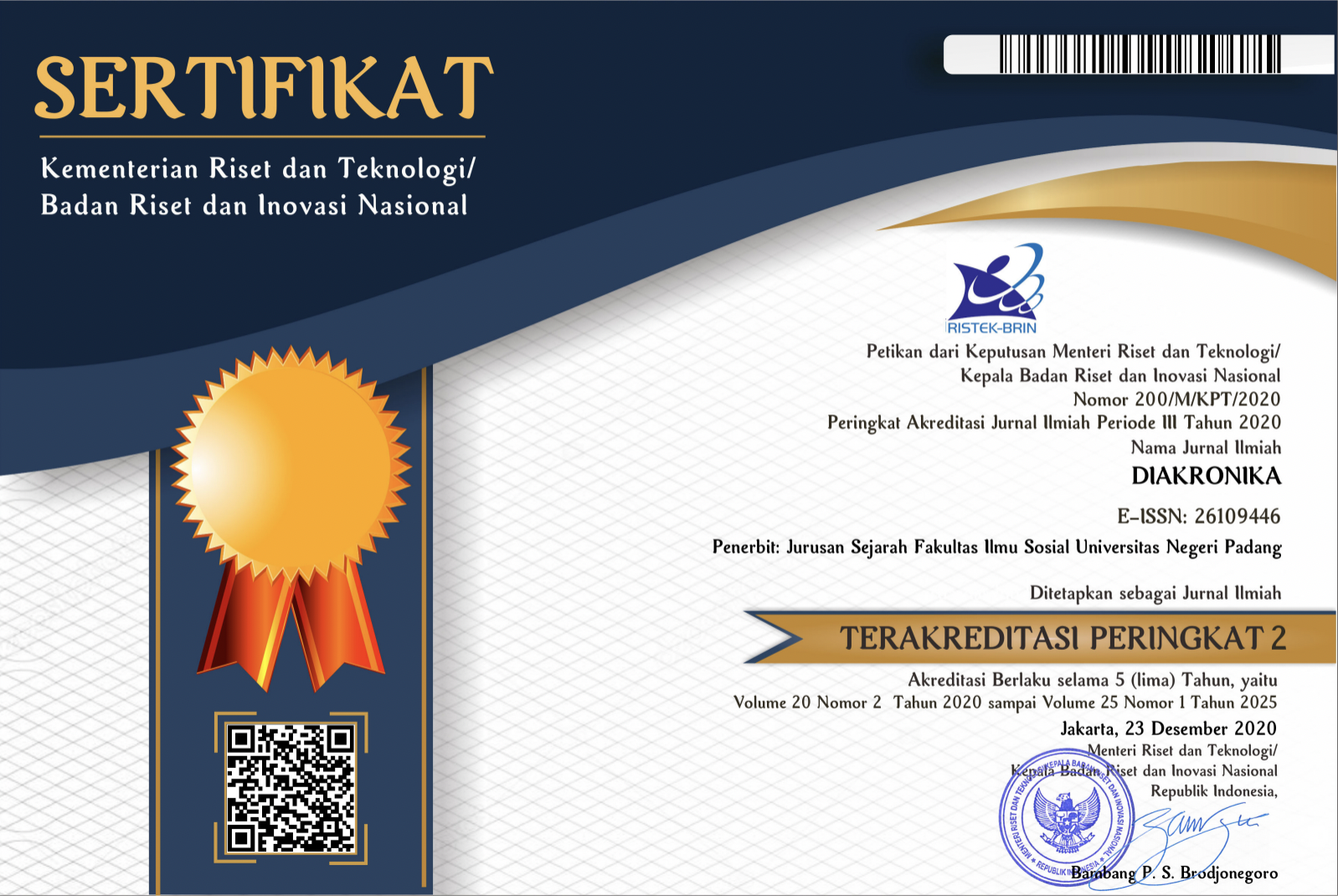Pengaruh Pembangunan Jembatan Cirahong terhadap Perkembangan Perkebunan di Kabupaten Galuh-Ciamis 1893-1942
Abstract
The writing of this article started from the author's interest in Dutch heritage buildings around the Tasikmalaya area, which still stand strong today. One of the most interesting is the Cirahong Bridge. This bridge was built during the colonial period as a means of transportation. According to the blueprint, the Cirahong bridge is the only multifunctional bridge in Indonesia because the upper part is used for the train line, while the lower part is used for connecting cars and motorbikes from Manonjaya to Ciamis. The construction of this bridge is also interesting because it involves several political lobbies from the Galuh rulers (ciamis) who want to change the train line from its original direction towards Cimaragas to Ciamis. This lobby bears sweet fruit with the change of route to Ciamis. This study aims to determine the development of the Cirahong railway bridge and its impact on the development of plantations in the Galuh-Ciamis Regency. This article uses the Historical Method, which includes the stages of heuristics, criticism, interpretation, and historiography. The construction of the Cirahong Bridge, which began in 1893, took seven months in the manufacturing process. The construction of this bridge was a must after the Bogor-Cilacap railway line switched from Cimaragas to Ciamis as a result of political lobbying from RAA Kusumadiningrat. This political lobby bore fruit for Galuh because it had a direct impact on Galuh's economy, marked by the construction of 39 new plantations and the emergence of many new jobs related to rail transportation facilities in Galuh due to the existence of a train line passing through Galuh.
Downloads
References
Algemeen Handelsblad Voor Nederlandsch Indië 20 Maart 1936. (1936). 68.
Alian. (2012). Metodologi Sejarah Dan Implementasi Dalam Penelitian. Criksetra, 2(2), 1–17.
Berg, K. (1892). Soerabajasch Handelsblad.
Bernard, S. (1911). Kolff’s 3- cents Spoorboekje.
Brinkman, F. A. (1939). Brinkman’s cultuur-adresboek voor Ned.Indië. NV Reiss & Co.
Gravenhage, S. (1897). Verslag de Staatsspoorwegen in Ned. India over Het Jaar.
Hardjasaputra, A. S. (2002). Perubahan Sosial di Bandung 1810-1906. Universitas Indonesia.
Hekmeijer, F. C. (1925). Groundhuurverordeningen. G.kolff & Co.
Hermawan, I. (2016). KETERKAITAN JALUR KERETA API BATAVIA – CILACAP DENGAN SISTEM PERTAHANAN HINDIA BELANDA DI PULAU JAWA The Relation between The Railway Routes of Batavia - Cilacap And The Defense System of Dutch Colonial Government in Java Island. PURBAWIDYA: Jurnal Penelitian Dan Pengembangan Arkeologi, 3(2), 129. https://doi.org/10.24164/pw.v3i2.41
Kuntowijoyo. (2003). Metodologi Sejarah. Tiara Wacana Yogya.
Laoura, A. (1890). Kunstwerk Spoorwegbrug tevens brug voor gewoon verkeer over de Tjitandoei.
Lijst van Ondernemingen in Nederlansche Indië. (1914). Landsdrukkerij.
Marliana, R. (2008). Perkembangan Perkebunan Karet Tjipetir Sukabumi (1885-1942). Universitas Padjadjaran.
Mulyana, A. (2017). Sejarah Kereta Api di Priangan. Ombak.
Nederlandsch-Indische Spoorweg Maatschappij, Aantekeningen, Conssesien en Vergunningen. (1902).
Nurlaila, L. (2016). Situs Perkebunan Karet Cisaga di Kabupaten Ciamis 1908-1972 : Kajian Arkeologi Industri Tentang Kode Budaya Kolonial. Universitas Indonesia.
Reistma, S. . (1916). Dienst der Staatsspoorwegen in Nederlands Indie Mededelingen 1e Afdeeling no 1 Indische Spoorweg-Politiek deel 1 (1st ed.). Landsdrukkerij.
Reistma, S. . (1925). Staatsspoor En Tramwegen in Nederlandsch Indië 1875-1925. Topografische Inrichting Weltevreden.
Salzwedel, H. (1900). Aanleg van het viaduct van de Staatsspoorwegen over de Tjitandoej tussen Manondjaja en Tjiamis. 1900. https://digitalcollections.universiteitleiden.nl/view/item/918196?solr_nav%5Bid%5D=4bea449770cc207b79dc&solr_nav%5Bpage%5D=0&solr_nav%5Boffset%5D=0 puan dari pilar Jembatan.
Sjamsudin, H. (2007). Metodologi Sejarah. Yogyakarta: Ombak. Ombak.
Sofiani, Y. (2012). GAYA-GAYA HIDUP BUPATI-BUPATI GALUH. Ombak.
Sofiani, Y. (2021). Ensiklopedia Bupati Galuh 1618-1914. Layung.
Stemfoort, J. W., & Siethoff, J. J. ten. (1900). Kaart van Java en Madoera aangevende de spoorweg-, tramweg-, telegraaf- en telefoonverbindinge. Topographische Inrichting. https://vu.contentdm.oclc.org/digital/collection/krt/id/2840/
Stemvoort, J. W., Hora Adema, J., & Cie., J. en. (1885). Spoorweg kaart van Java en Madoera. Jos Smulders En Cie. https://socrates.leidenuniv.nl/view/item/56875?solr_nav%5Bid%5D=bae4086bdd7d223ff56f&solr_nav%5Bpage%5D=22394&solr_nav%5Boffset%5D=0
Struktur Jembatan di Priangan. (1956). Majalah Djawatan Kereta Api.
Sukmana, W. J. (2021). Metode penelitian sejarah. Universitas Lambung Mangkurat, 1(April).
Sumargono. (2021). Metodologi Penelitian Sejarah. Lakeisha.
Sutardi, M. H. A., & Martina, K. (2015). Strategi Pengembangan Transportasi dalam Mendukung Pengembangan Wilayah (Studi Kasus : Pulau Misool, Kabupaten Raja Ampat). Jurusan Teknik Planologi, Universitas Esa Unggul, 6, 1–8.
Swart, A. G. . (1911). Rubber Companies in The Netherlands East Indies. J,H. de Bussy.
Verslag der Staatsspoorwegen 1936. (1936).
Verslag Omtrent Staatsspoorwegen 1890-1895. (n.d.).
Vissering, G. (1914). Internationaal Rubbercongres Met Tentoonstelling. N. V . MIJ. VORKINK.
Weijerman, A. W. . (1904). Geschiedkundig Overzicht van het Ontstaan der Spoor en Tramwegen in Nederlandsch-Indie. Javasche Boekhandel & Drukkerij.
Winata, A. K. (1937). R.R Tjiamis. Tawekal.
Yulifar, L. (2014). Kabupaten Galuh-Ciamis 1809-1942 (Pemerintahan, Sosial-Ekonomi, dan Politik). Universitas Padjadjaran




